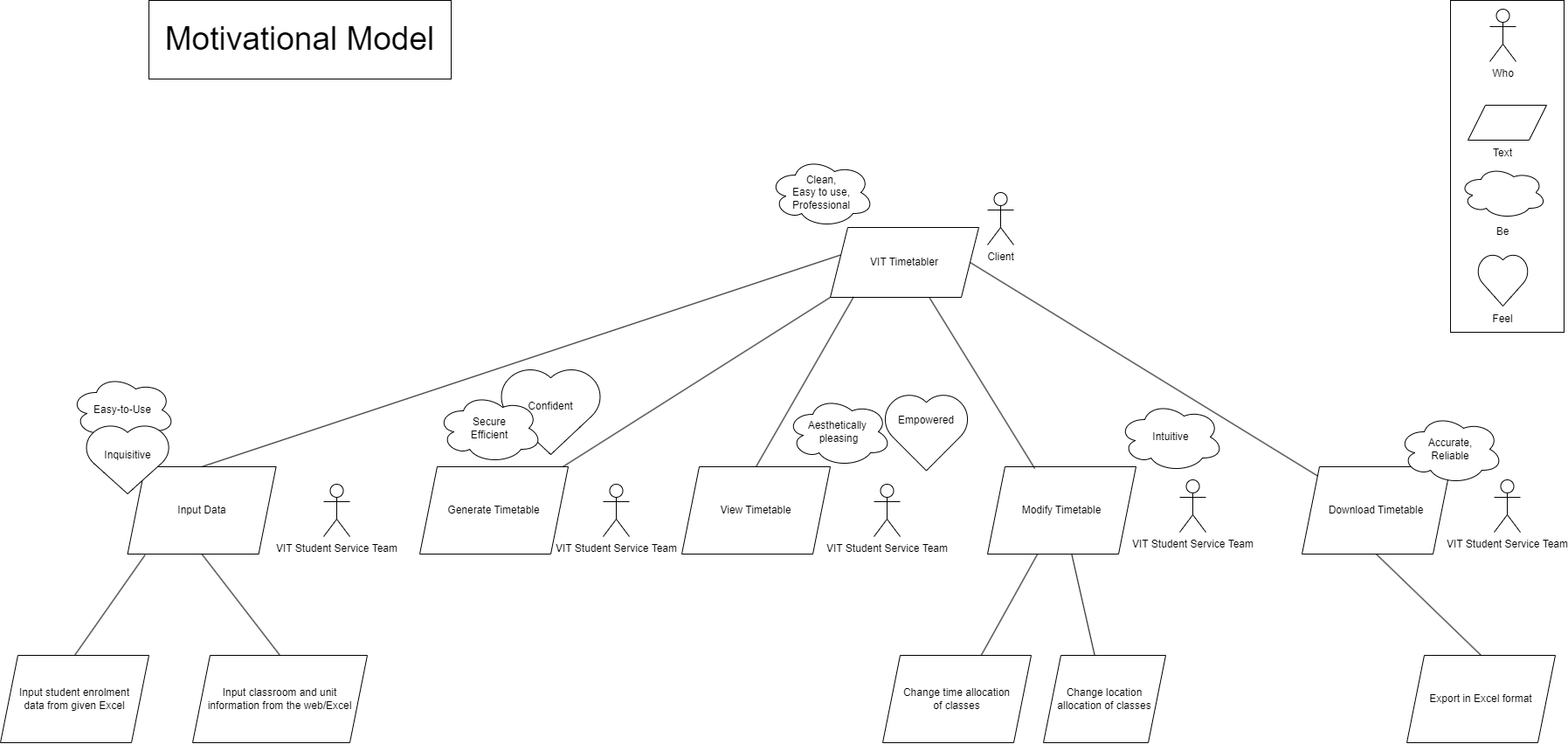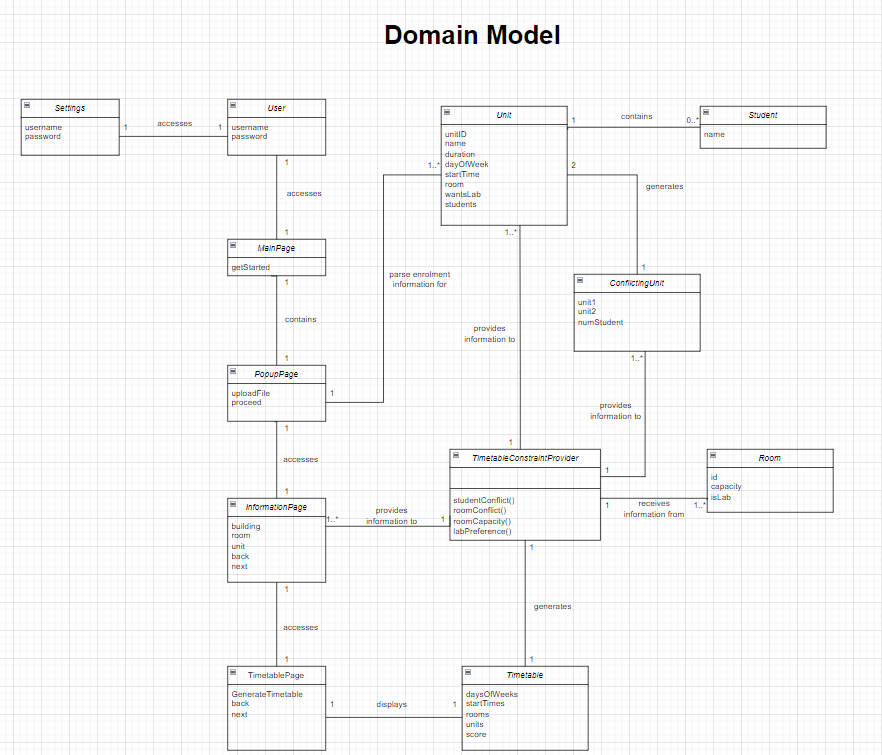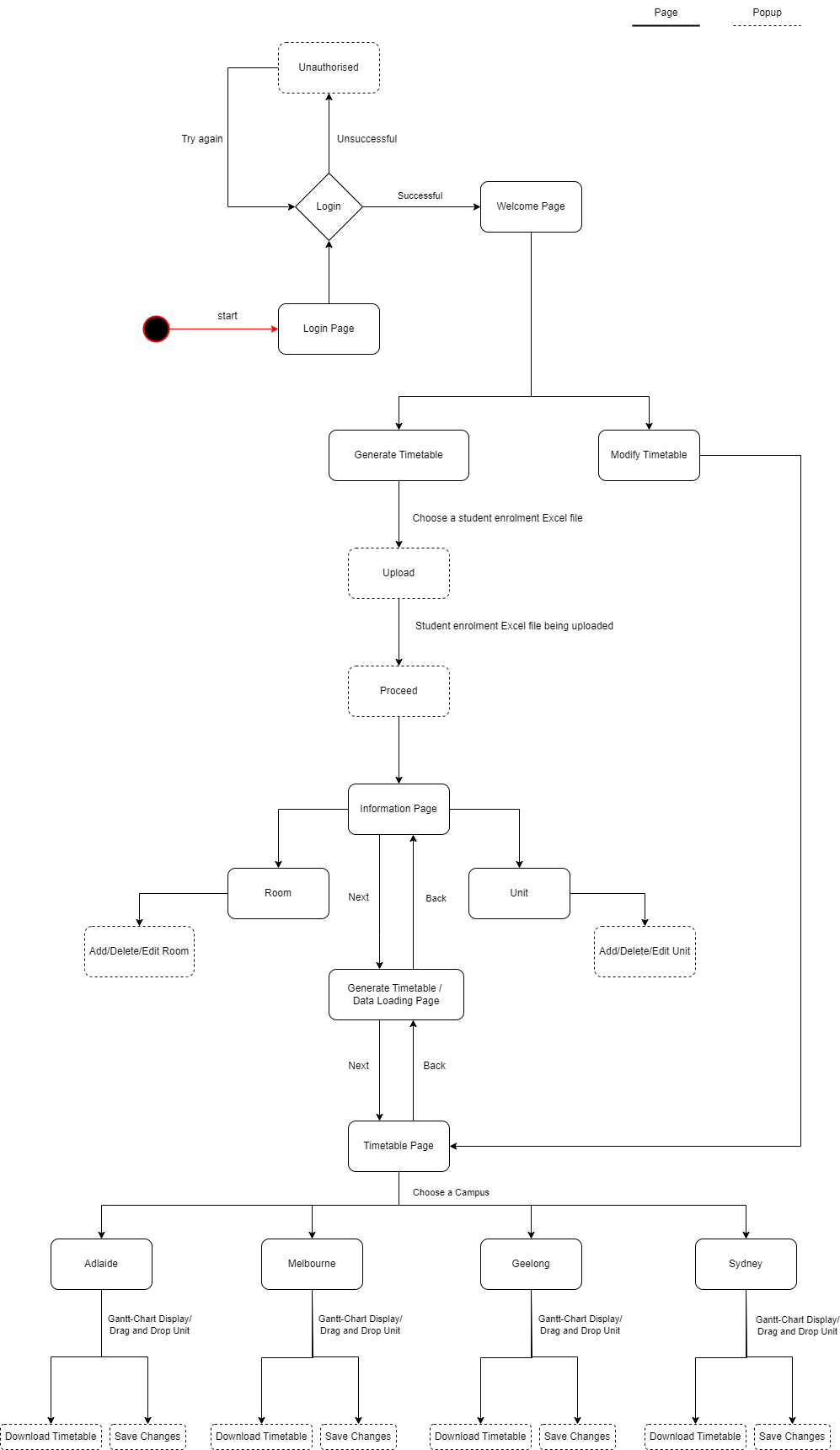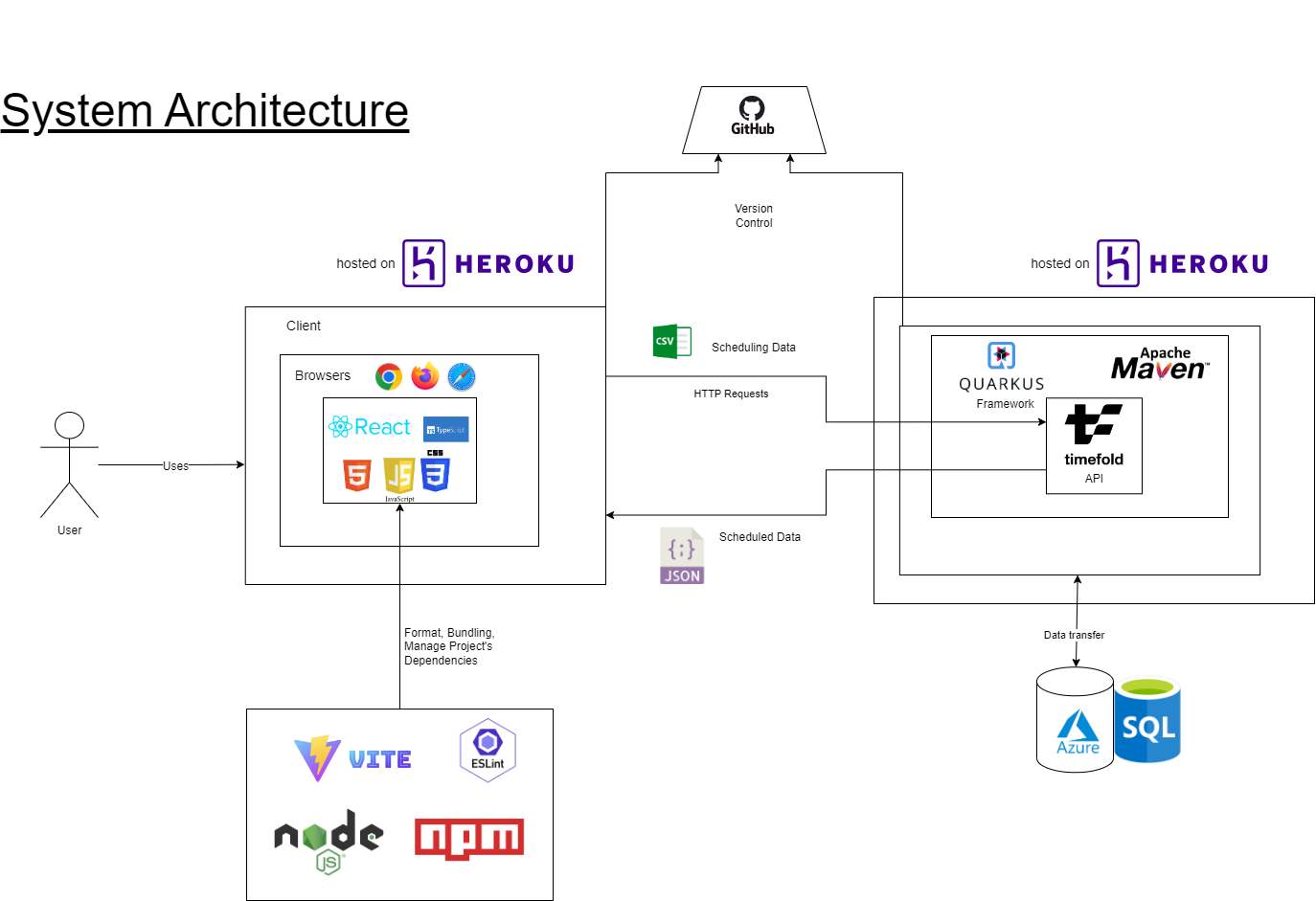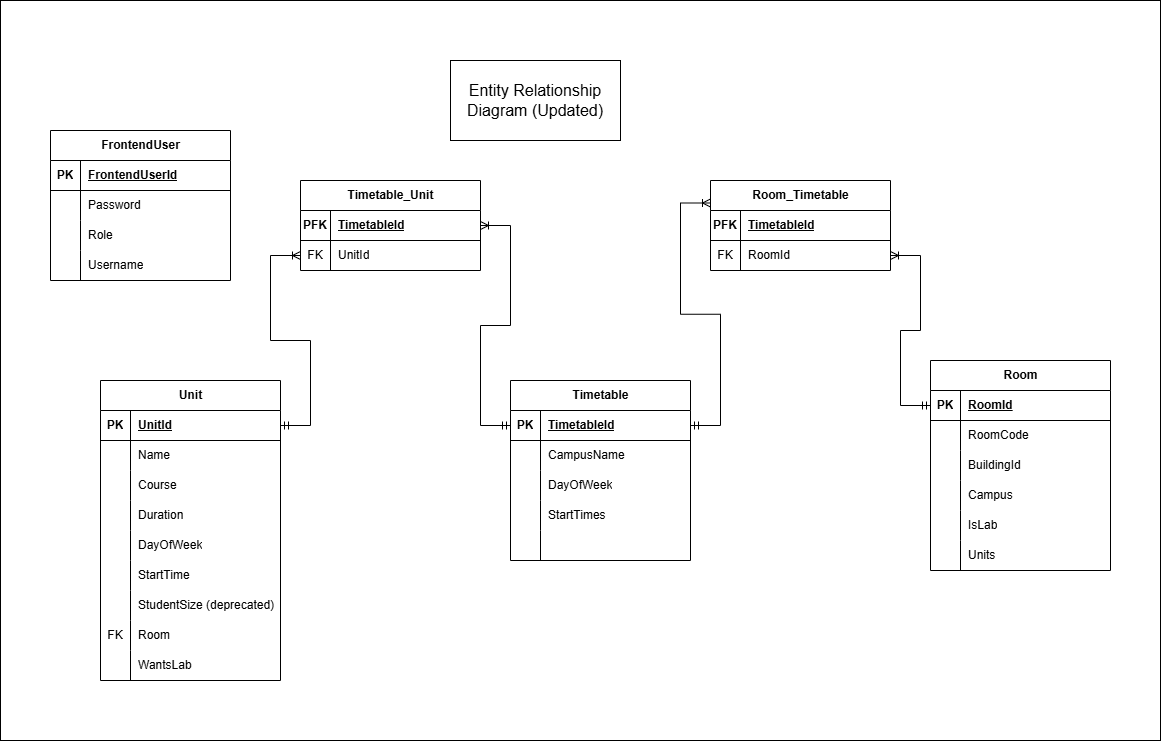Timetabling for VIT is a web application designed to automate the unit timetabling process for the Victorian Institute of Technology. The platform optimizes class schedules, taking into account room availability, course requirements, and student availability to ensure efficient use of resources and a seamless scheduling experience.
https://vit-timetabling-230c1835ad5a.herokuapp.com
Login
Users can log in with a pre-set username and password provided by Team Jet Edge.
Welcome Page
After logging in, users are presented with two options:
- Generate Timetable: Starts the process of uploading a student enrolment Excel file to generate a new timetable.
- Modify Timetable: Allows users to edit existing timetables by navigating to the Timetable Page.
Upload File
- Selecting “Generate Timetable” on the Welcome Page brings up the "Upload File" pop-up window.
- Click UPLOAD FILE at the top to select and upload the student enrolment Excel file.
- After uploading, click PROCEED at the bottom to move to the Information Page.
Information Page
On the Information Page, users can edit room and unit information as needed.
- Certain columns (Campus, Course, Unit Code, Enrolled Students) in the Unit Table are parsed directly from the uploaded Excel file and cannot be modified.
- Right-clicking on a cell opens a context menu for more options, such as inserting or deleting rows.
- Editing the information page can be done by copying and pasting data from an existing pre-formatted Excel file.
Once editing is complete, click NEXT at the bottom right to proceed to the Generate Timetable page.
Generate Timetable
- Click GENERATE TIMETABLE to start the timetabling process.
- The processing icon will indicate progress and return to its original state once generation is complete.
- Click NEXT at the bottom right to move to the Timetable Page.
Display and Modify Timetable
- Users can view the timetable by campus by selecting campus names on the left-hand side of the page.
- Drag-and-Drop Editing: Users can drag and drop units to adjust room and time allocations as needed. Click SAVE CHANGES to apply edits to the database.
- Note: The system will display a warning if:
- A unit overlaps with another time slot (“OVERLAPPED”).
- A unit is assigned outside a designated room (“ASSIGN ACTIVITIES TO ROOMS ONLY”).
Download Timetable
If no further changes are needed, click DOWNLOAD TIMETABLE at the bottom to download the campus timetable as a ZIP file.
Note: Each campus has a ZIP file containing three timetables, one for each course offered at that campus. Therefore, to download all 12 timetables (4 campuses × 3 courses per campus = 12 timetables), the user only needs to download four ZIP files, one per campus.
User Stories
| Issue key | Epic Name | User Story Name | User Story | Priority |
|---|---|---|---|---|
| KAN-51 | Automate Timetable Generation | Add workdays to algorithms | As a student support team member, I want the scheduling algorithm to work across 5 working days instead of just one day, so that we can create timetables for the entire week, offering more flexibility and better scheduling options for students. |
High |
| KAN-41 | Automate Timetable Generation | Connect to Azure database | As a Student Service team member, I want to store semester and campus information for later retrieval, So that I can view and edit them later down the line without having to re-enter all the data, which saves time and effort. |
High |
| KAN-32 | Automate Timetable Generation | Constraint 1: no students have overlapping units | As a student service team member, I want to implement a constraint that ensures no student has overlapping classes so that students can attend all their enrolled classes without any scheduling conflicts. |
Highest |
| KAN-45 | Automate Timetable Generation | Constraint 2: no overlapping units are in the same room | As a student service team member, I want to implement a constraint that ensures no two classes are scheduled in the same classroom at the same time so that there are no conflicts or double-bookings in the timetable, ensuring each class has a dedicated space. |
Highest |
| KAN-34 | Automate Timetable Generation | Constraint 3: ensure room capacity is not less than allocated unit size | As a student service team member, I want to implement a constraint that ensures the room size is greater than or equal to the class size so that all scheduled classes have adequate space for all enrolled students. |
Highest |
| KAN-52 | Automate Timetable Generation | Constraint 4: lab units prefer lab rooms | As a student service team member, I want to implement a constraint that ensures lab units are allocated to lab rooms whenever possible so that practical classes are held in appropriate environments conducive to hands-on learning. |
Highest |
| KAN-53 | Automate Timetable Generation | Constraint 5 (Room Availability Constraint): Filter the room in Front End (if a room is labelled not available, do not sent it to the backend). | As a student service team member, I want to label the rooms as available or not, so that only available rooms are scheduled. |
High |
| KAN-56 | Automate Timetable Generation | Front end persistence using indexedDB | As a Student Service Team member, I want all input data to be saved at least until I have finished inputting all data necessary for generating the timetable so that I can input all the data for the schedule process. |
High |
| KAN-57 | Automate Timetable Generation | Store and get info from database | As a Student Service Team member, I want to store semester and campus information for later retrieval, so that I can view and edit them later down the line without having to re-enter all the data, which saves time and effort. |
Medium |
| KAN-92 | General | Improve UI/UX design on frontend | As a Student Service Team member, I want the product to be aesthetically feasible, so that it would match with other VIT websites |
Lowest |
| KAN-91 | General | Skip button straight to timetable page | As a Student Service Team member, I want to be able to modify my previously generated timetable right away so that I can save time |
High |
| KAN-77 | Security | Basic Authentication at backend | As a Student Service Team member, I want to ensure that access to the backend is secured using Basic Authentication so that only authorized users can interact with the system. |
High |
| KAN-76 | Security | Integrate with backend Basic Auth + reroute to login page | As a Student Service Team member, I want the application to be secure so that only authorised personnel can access the website to use its functionalities and view VIT’s timetables. |
High |
| KAN-37 | Store Timetable Input Data | Allow classes to take up more than 1 timeslot | As a Student Service Team member, I want to be able to make timetables with class durations of varying length so that I can have flexibility in the classes I plan to have at my institution, and still be able to generate a timetable for them. |
Highest |
| KAN-26 | Store Timetable Input Data | Build campus data input page | As a member of the Student Service Team, I want to input information about each campus so that the timetables I want to generate is specific to each campus. |
Medium |
| KAN-27 | Store Timetable Input Data | Build classroom/lab data input page | As a member of the Student Service Team, I want to input information about each building and classroom so that lessons can be allocated to a physical location. |
Medium |
| KAN-25 | Store Timetable Input Data | Build course data input page | As a member of the Student Service Team, I want to input information about each course so that the timetable for students enrolled in each course is different. |
Medium |
| KAN-24 | Store Timetable Input Data | Build file upload page for enrolment info | As a member of the Student Service Team, I want timetables to be generated using the enrolment information of the current semester so that classroom/space allocation will be efficient and adjust dynamically between semesters. |
Highest |
| KAN-36 | Store Timetable Input Data | Client side page routing | As a Student Service Team member, I want lower load time when navigating between pages, so that I can get my tasks done faster. |
Medium |
| KAN-39 | Store Timetable Input Data | Connect Quarkus backend with React frontend | As a Student Service Team member, I want to enter data and for it to be processed to generate a timetable. so that I can have an automated and quick way to create timetables, without loads of manual labour. |
Medium |
| KAN-20 | Store Timetable Input Data | Design data Input UI | As a member of the Student Service Team, I want the system to have an user-friendly data input interface, so that I can submit information for generating timetables quickly. |
High |
| KAN-21 | Store Timetable Input Data | Setup database | As a Student Service Team member, I want to store semester and campus information for later retrieval, So that I can view and edit them later down the line without having to re-enter all the data, which saves time and effort. |
Highest |
| KAN-43 | Store Timetable Input Data | Take into account classrooms and labs priority constraint | As a Student Service Team member, I want to prioritize the allocation of specific classrooms and labs based on their suitability for certain courses so that the timetable reflects the optimal use of resources, ensuring that specialized spaces are reserved for classes that require them. |
High |
| KAN-59 | Store and get info from database | Store generated timetable to database | As a Student Service Team member, I want to store semester and campus information for later retrieval, so that I can view and edit them later down the line without having to re-enter all the data, which saves time and effort. This is not completed for Sprint 1 due to our change of backend framework. This will be moved to Sprint 2. |
Medium |
| KAN-58 | Store and get info from database | Store student enrolment info from .xlsx file | As a Student Service Team member, I want to store semester and campus information for later retrieval, So that I can view and edit them later down the line without having to re-enter all the data, which saves time and effort. |
Medium |
| KAN-69 | Testing and Deployment | Backend deployment | As a Student Service Team member, I want the backend of the application to be properly deployed so that it reliably processes data and supports frontend interactions. |
High |
| KAN-62 | Testing and Deployment | Backend Unit Tests | As a developer, I want to thoroughly test the backend functions and modules, so that I can catch bugs early, validate the behaviour of APIs, and verify the correctness of business logic, ensuring that all unit tests pass when individual components are tested in isolation. |
High |
| KAN-87 | Testing and Deployment | Connect deployed frontend to the deployed backend | As a Student Service Team member, I want the application to generate timetables using a deployed backend so that I don’t have to run the backend locally. |
Highest |
| KAN-68 | Testing and Deployment | Frontend deployment | As a Student Service Team member, I want the front end of the application to be properly deployed so that I can access and interact with the system’s interface seamlessly. |
High |
| KAN-65 | Testing and Deployment | Frontend Unit Tests | As a Student Service Team member, I want the application UI to be free of bugs so that I can work efficiently. |
Medium |
| KAN-82 | Testing and Deployment | Integration Tests | As a Student Service Team member, I want the application to be able to communicate seamlessly with the backend so that I can work coherently. |
Medium |
| KAN-83 | Testing and Deployment | Security Tests | As a backend developer, I want the backend to enforce secure access to endpoints, so that unauthorized users cannot access sensitive data or system functionalities. |
Medium |
| KAN-94 | Testing and Deployment | System Tests | As a system tester, I want to test the entire timetable system comprehensively, including functional, usability, and performance aspects, so that I can ensure it meets the specified requirements and works seamlessly in real-world scenarios. |
High |
| KAN-95 | Testing and Deployment | User Acceptance Tests | As a student service team member or administrator, I want to interact with the timetable system in a real-world scenario, so that I can verify that the system meets my needs, is easy to use, and satisfies all business requirements. |
High |
| KAN-84 | View and Edit Timetable | Change website tab name to "Timetabling for VIT" | As a Student Service Team member, I want the application to have a consistent VIT theme so that this application is made for VIT. |
Low |
| KAN-49 | View and Edit Timetable | Display Gantt Chart for received data | As a Student Service Team member, I want the auto-generated timetable to have a clear display format so that I can easily view and make modifications. |
High |
| KAN-74 | View and Edit Timetable | Ensure database only stores one timetable for each campus at all times | As a Student Service Team member, I want to only have one timetable for each campus at all times, i.e. each time I generate a new timetable for a campus, any existing timetable for that particular campus should be removed So that I don’t have to sift through a lot of timetables and always be focused on just one |
High |
| KAN-75 | View and Edit Timetable | Fix database, prevent leaking large input files | As a Student Service Team member, I want to have all the data I enter into the system saved So that I can retrieve these data later |
High |
| KAN-50 | View and Edit Timetable | Handle download timetables | As a Student Service Team member, I want to download the auto-generated timetable(s) so that I view them locally on my own PC and set up timetables for my students. |
High |
| KAN-60 | View and Edit Timetable | Handle dynamic routing with dynamic campus inputs | As a Student Service Team member, I want to view the timetable of 1 campus per Gantt chart so that any changes in room/time allocation I make will not clash with other classes happening on the same campus. If more campuses are added in the future, the web-application should be dynamic and display timetables for those new campuses in new tabs as well. |
High |
| KAN-71 | View and Edit Timetable | Modify DB schema to allow storage of timetables by campus | As a Student Service Team member, I want to view timetables by campus So that I can know the classes happening for each campus during the semester and modify accordingly since classes can’t be changed across campuses. |
High |
| KAN-86 | View and Edit Timetable | Remove the "Building" tab from input spreadsheets page | As a Student Service Team member, I want the UI to not contain unnecessary elements so that I can focus on my tasks. |
Low |
| KAN-80 | View and Edit Timetable | Save unit drag-and-drop changes to database | As a Student Service Team member, I want to drag and drop to modify existing timetables and have those changes saved So that when I return to the timetable, it always has the latest changed applied, and I can keep modifying from there |
High |
| KAN-73 | View and Edit Timetable | Split user input by campus before sending to backend | As a Student Service Team member, I want the application to generate 1 timetable for each campus so that each campus is constrained separately by their available buildings. |
High |
| KAN-72 | View and Edit Timetable | Update frontend API method to match latest backend | As a Student Service Team member, I want the process of communicating with the backend to work seamlessly, so that I can generate a timetable from my input. |
High |
| KAN-85 | View and Edit Timetable | Update pages to show loading state whilst processing data | As a Student Service Team member, I want the application UI to feel interactive when it’s loading, so that I know I am waiting on something to be done. |
High |
This timetabling web application is built with the following coding and deployment environment configurations (please find setup guides linked for each):
-
Windows 11 (ideal): the project was developed solely on Windows 11 machines.
- If you use another operating system, there may be slight differences to configuration, but this will be beyond the scope of this document.
-
Java Development Kit (JDK) version
22.0.2: language for backend development.- Minimum requirement: JDK 17+ with
JAVA_HOMEconfigured appropriately on your machine.
- Minimum requirement: JDK 17+ with
-
Apache Maven version
4.0.0: build-automation and project management tool for Java-based projects. -
PostgreSQL version
16.4: database for timetable storage.- Offers pgAdmin for data administration and further manipulation (comes with standard download).
-
Node.js version
20.17.0: JavaScript runtime environment for frontend development. -
Git version
2+: version control and collaborative development.- Git preserves backwards compatibility very well, any recent version should work fine, too.
-
Heroku CLI version
7.0.0: deployment and workflow management. -
For the versions of plugins, packages, and frameworks used, they are specified in the configuration files of the repository and you do not need to perform any installations or take any additional action. Please refer to:
-
The
jetedge/backend/pom.xmlfile located in the repository for backend dependencies. -
The
jetedge/frontend/package.jsonfile located in the repository for frontend dependencies.
-
If you wish to build upon the codebase, please first ensure your machine meets the prerequisites outlined in the previous section, then follow the steps below to create a local coding environment.
-
Navigate to the JetEdge GitHub repository and fork it.
-
In your terminal of choice, navigate inside the folder in which you wish to clone the forked repository.
-
Clone the forked repository.
git clone https://github.com/{your-github-name}/jetedge.git
- Navigate inside the cloned folder.
cd jetedge
- Navigate inside the backend folder for backend setup.
cd backend
-
Create a
.envfile inbackendfolder with database and login information -
Navigate inside the frontend folder for frontend setup.
cd frontend
-
Create a
.envfile with the login information.- These constants are for testing purposes, please ensure they are consistent with the credentials in the backend/.env file.
-
Install dependencies.
npm install
-
In preparation to run the code locally, please navigate inside
frontendfolder and replace all instances of the constantREMOTE_API_URLwithLOCAL_API_URL. -
Run the frontend and backend simultaneously in development mode, with two separate terminal windows
-
Run the frontend in development mode.
cd jetedge/frontend
npm run dev
- Run the backend in development mode.
cd jetedge/backend
./mvnw compile quarkus:dev
If you wish to run the servers in production mode locally:
- Execute the following to build and run the frontend server in production mode.
cd frontend
npm run build
npm run preview
- Execute the following to package and run the backend server in production mode.
cd backend
./mvnw package
java -jar target/quarkus-app/quarkus-run.jar
If you wish to perform data administration tasks on the Azure cloud-based PostgreSQL database we provide, please follow the guide to connect the cloud database with your local pgAdmin.
If you wish to set up your own PostgreSQL database, please read the steps below to help you get started.
Firstly, for context, the JetEdge team used an Azure Student License for the duration of this project. The setup will vary depending on the type of license you have and we presume VIT will not be using the Student License. Therefore, we will provide an overview of how to set up your own database along with the resources you will find helpful.
If you are considering to use Azure database for PostgreSQL, please check Azure’s pricing model here: https://azure.microsoft.com/en-au/pricing/details/postgresql/server/
Now if you decide to go ahead with setting up your own Azure PostgreSQL database, the first step is to create an account for the Azure portal, then perform database setup and deployment on Azure. This video provides a step-by-step setup guide for someone with a general license: https://www.youtube.com/watch?v=AsL7MI8b0m4
After this, please extract the datasource username, password, and JDBC url, and enter them into the .env. file located in the backend folder for the appropriate constants.
This should complete the setup. Once you run the Quarkus backend server, the necessary tables in the database will be automatically set up and ready for use.
You can deploy this site to any hosting platform of your choice, but we have selected Heroku. To ensure smooth deployments and updates, follow the steps outlined below for managing the frontend and backend of the "Timetabling for VIT" application.
Frontend Deployment
- Current Deployment URL
- Process: The frontend is deployed as a Node.js app on Heroku.
- Update Instructions:
- Automatic Deployment: Push updates to the
mainbranch on GitHub to automatically trigger the CI/CD pipeline for deployment on Heroku. - Manual Deployment: If needed, log in to Heroku, access the frontend app, and deploy manually via the Heroku CLI.
- Automatic Deployment: Push updates to the
Backend Deployment
- Current Deployment URL
- Process: The backend is deployed as a Java app on Heroku.
- Update Instructions:
- Automatic Deployment: Push updates to the
mainbranch on GitHub to automatically trigger the CI/CD pipeline for deployment on Heroku. - Manual Deployment: If needed, log in to Heroku, access the backend app, and deploy manually via the Heroku CLI.
- Automatic Deployment: Push updates to the
CI/CD Pipeline
- Platform: GitHub Actions
- Pipeline Link
- Setup: The pipeline automates deployments for both frontend and backend. Pushing to the
mainbranch triggers automatic deployment to Heroku.
Notes
- Environment Variables: Ensure all required variables are updated in your local environment, GitHub Actions secrets, and Heroku app settings
FRONTEND_USERNAME,FRONTEND_PASSWORD: Login details for accessing the website.HEROKU_EMAIL,HEROKU_API_KEY,HEROKU_FRONTEND_APP_NAME,HEROKU_BACKEND_APP_NAME: Heroku credentials for automated deployment.QUARKUS_DATASOURCE_USERNAME,QUARKUS_DATASOURCE_PASSWORD,QUARKUS_DATASOURCE_JDBC_URL: Database credentials for the backend.
- Error Handling: Review Heroku logs for any deployment or runtime issues. Logs are accessible via the Heroku dashboard or by running
heroku logs --tailin the command line. - Security: Keep all credentials secure by storing them in environment variables and avoid hard-coding sensitive information.
-
Removed deprecated student endpoints, renamed API endpoints for consistency #55
-
bugfix: sidebar now does not overflow into headers #53
-
Reformatted the “enrolment“ page, “Save Changes“ and “Download Timetable“ button will now always be visible in the “timetablemod“ page #52
-
”Save Changes” now saves timetable’s changes into database #51
-
Deployed frontend now uses the deployed backend #46
-
Add a skip button to jump directly to the previously generated timetable #44
-
Disable buttons in “senddata“ when timetable is not yet generated, only enabling when backend has finished generating #43
-
Removed the “Building“ tab from the sidebar in “seminfo“ #41
-
Update tab name to “Timetabling for VIT“ #39
-
User authentication required for database access, routes are now private and login is required on frontend #35
-
Implement dynamic sidebar, able to update accordingly to campuses sent from backend. Timetable are now displayed in gantt-chart format #32
-
Increase transaction timeout limit, and removed the storage of students for faster transactions #31
-
Deploy frontend #23
-
Handle empty input in “seminfo“: an alert will pop up if input is empty while trying to solve a problem. Unit List in “seminfo/units“ are now also read-only #13
-
Frontend is now connected to a functional backend #10
-
Persistence in the frontend “seminfo“ page #9

